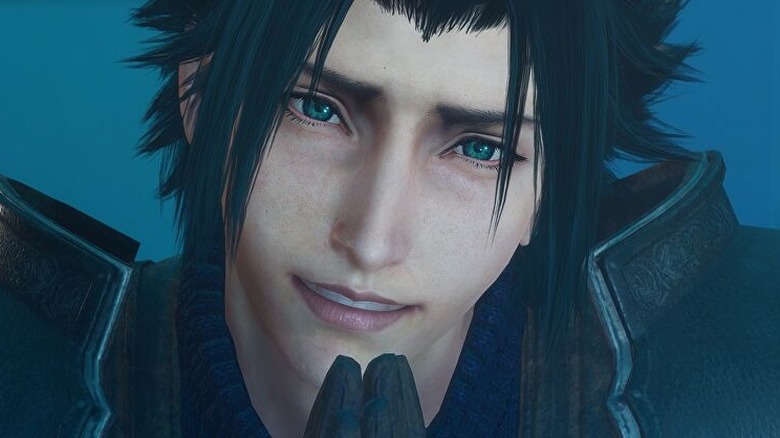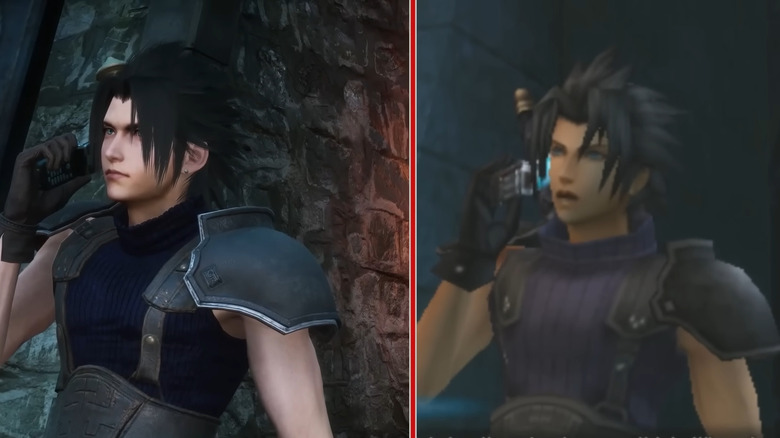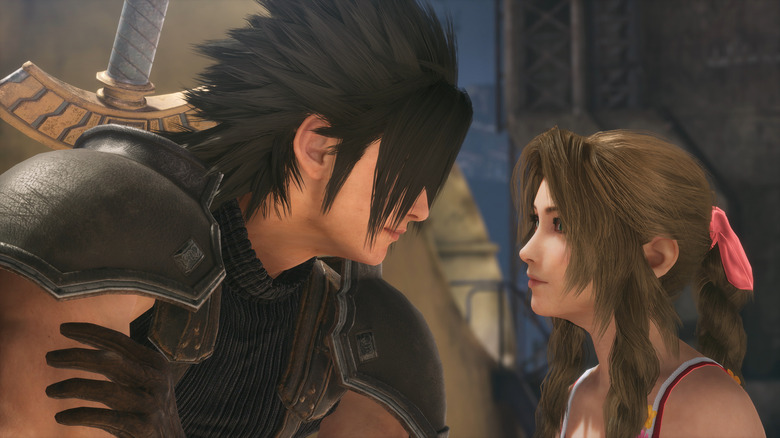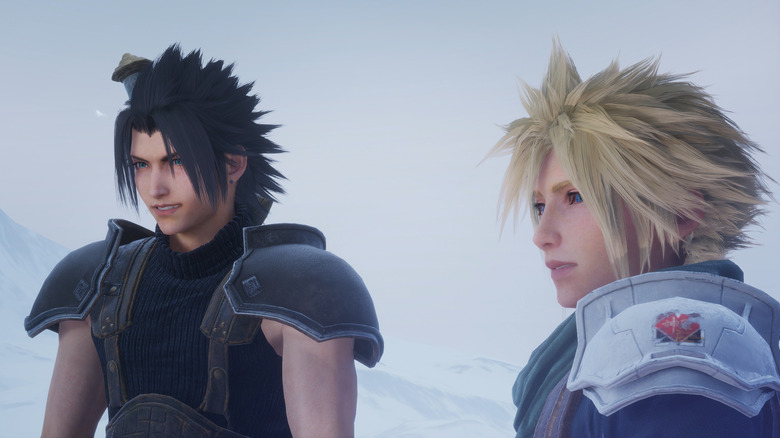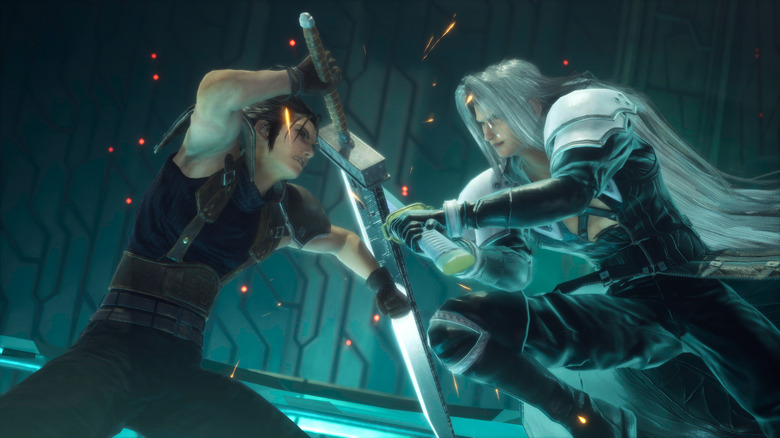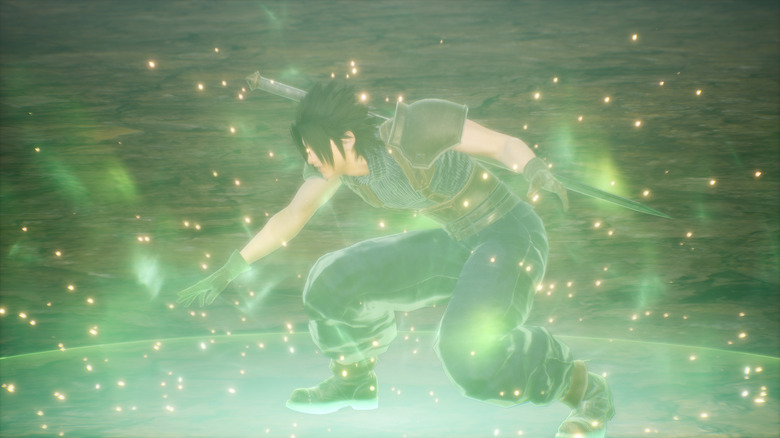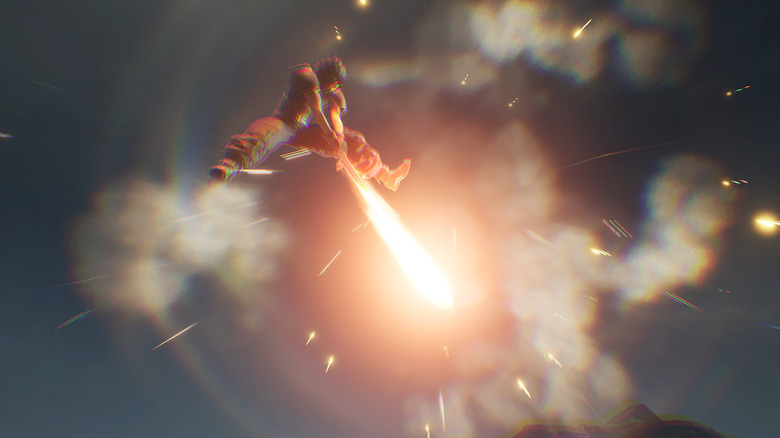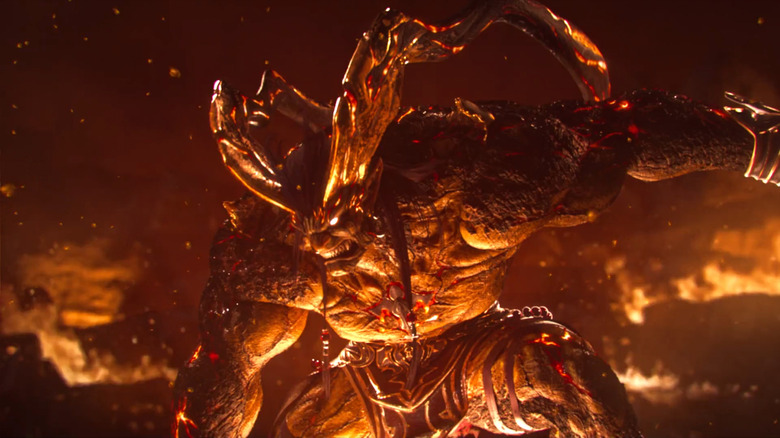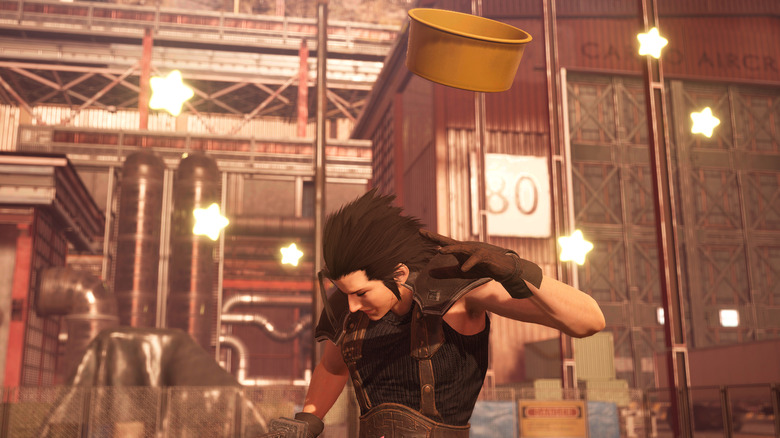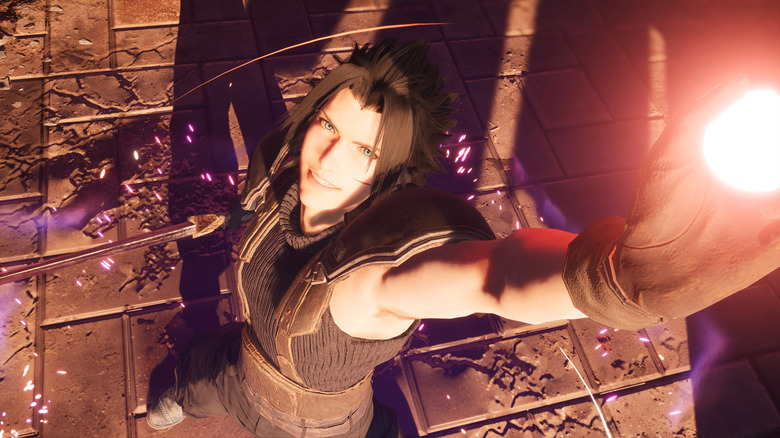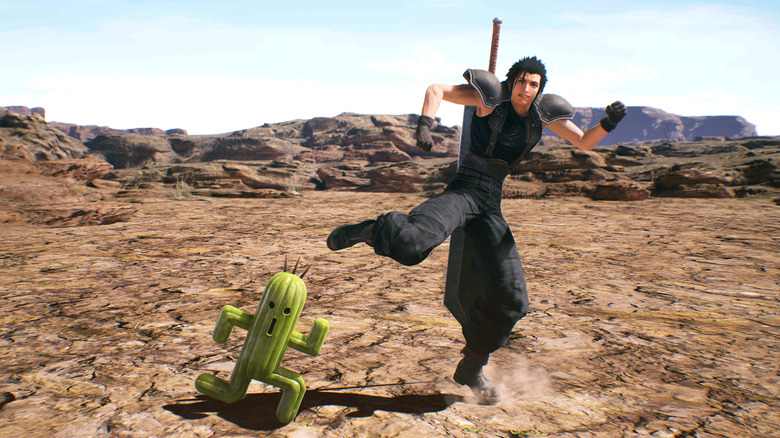What Crisis Core: Final Fantasy 7 - Reunion Does Better Than The Original
In April 2020, Square Enix released "Final Fantasy 7 Remake," the first of what would become a series of re-releases for the powerhouse studio. The second remade title in this series, "Crisis Core: Final Fantasy 7 – Reunion," released in December 2022 and differs quite a bit from Square Enix's treatment of "Final Fantasy 7 Remake."
Tetsuya Nomura, creative director and character designer for "Reunion," has described the game as somewhere between a remaster and a complete remake (per Gamer Braves). The new game has completely revamped graphics and significant mechanical changes, but it doesn't change the story at all. As a result, classifying the new "Crisis Core" as either a remaster (new graphics), or a remake (new gameplay), was too difficult, so the term "Reunion" was chosen as a sort of middle ground.
So, what exactly did Square Enix change about "Crisis Core: Final Fantasy 7," which was already an innovative game when it was released on the PSP back in 2007? Let's take a look at the biggest changes, as well as how critics and fans have responded to them.
Total graphical overhaul
"Crisis Core: Final Fantasy 7" came out in 2007 on the PSP and the passage of time might be most noticeable when comparing the improvements in graphics (per IGN). The PSP's limited hardware capabilities required "Crisis Core: Final Fantasy 7" to be coded in C++, whereas "Reunion" is coded in Unreal Engine 4, giving the devs access to high-end graphical capabilities across all platforms. In fact, "Reunion" has been so thoroughly updated in terms of graphics that it can be rendered in 4k resolution on high-end consoles and PCs.
Many remastered games opt for just a new coat of paint or updated textures, but "Reunion" went several steps beyond. On top of new textures, "Reunion" received upgrades to its ambient lightning, post-processing effects, framerate, and cinematics. Specifically, the game's many cutscenes were reworked with a new AI image upscaling technique. In contrast, however, the game's iconic Summon animations were redone from scratch for that extra oomph.
Interestingly, many of the game's original character models and baked-in animations remain the same. Only a few improvements to models were made, like giving hands added flexibility. According to an expanded press release from Square Enix, the surprising way in which these models stood the test of time inspired the team behind the remaster to "develop this new version properly as the inheritors of that spirit."
Brand new voiceovers
One of the biggest changes in "Final Fantasy 7 Remake" was its inclusion of a fully voiced cast of characters, which stands in stark contrast to the text-based dialogue of the original game. In a similar fashion, "Crisis Core: Final Fantasy 7 – Reunion" opted to have a cast record dialogue for the new game.
In fact, the voice cast for "Final Fantasy 7 Remake" and "Reunion" are the same, as Square Enix has attempted to keep this newer crew of voice actors consistent across the franchise. Caleb Pierce returns to voice Zack, the main character of "Reunion," delivering a performance that Inverse said "really [hones] in on the character's 'innocent puppy' persona." Not everyone loved this decision, however, and fans of the original voice cast started a petition (with over 1000+ signatures) for Square Enix to include an option in "Reunion" to use Rick Gomez's original voice recording for Zack.
In any case, RPGs seek to immerse the player in the game-world, and adding quality voice acting to every character in every scene goes a long way toward providing that element.
Quality-of-life improvements
Since the original "Crisis Core: Final Fantasy 7" released on the handheld PSP console, many of the game's core considerations revolved around that experience — combat with one joystick, a menu scrolling system using the PSP's bumpers, a whole host of mini-game experiences aimed for short play sessions, etc. Moving from the PSP to all consoles and PCs — as well as having more game development experience and player feedback about the original game — has paved the way for numerous quality-of-life improvements in "Crisis Core: Final Fantasy 7 – Reunion."
First, the entire UI and player HUD has been revamped to match the modernized menu systems in "Final Fantasy 7 Remake." One of the most clunky aspects of the original "Crisis Core: Final Fantasy 7" is its cumbersome menu system, so these upgrades boost gameplay smoothness. Second, the camera is now unlocked and is completely controlled by the player. Having only one joystick on the PSP made this impossible, and players from back in the day complained about this on community forums, so this is another welcome modernization.
Lastly, other small updates have been made, like the ability to dash between zones where there is no combat and new programmable keybinds across platforms. So despite Square Enix's recent sale off of some of its IP, it is clear the company intends to continue to polish up and improve the "Final Fantasy" franchise.
Combat fluidity
When "Reunion" is talked about as being "more than a remaster," the biggest difference being referred to here might be the multitude of drastic changes to the combat system. The original "Crisis Core: Final Fantasy 7" featured a hybrid combat system that incorporated elements from action-RPGs and turn-based strategy games. In combat, players were free to move around, but they could only queue attacks after their enemies attacked. This occasionally resulted in a clunky experience wedged halfway between both genres. And that's not even taking into account how the DMW (Digital Mind Wave) mechanic, the slot-based combat randomizer unique to "Crisis Core," also stopped combat dead in its tracks while players waited for its results, ultimately adding to the weird, stop-and-start feeling of the combat.
Thankfully, "Reunion" turns all of those experimental ideas into a more cohesive and fun experience. All of the turn-based elements have been removed for a more free-flowing style of gameplay. Also, the DMW's randomized elements activate in the background, and when they line up for Summons, the player can choose when to fire them off. This last change was a welcome addition for players like Kotaku's Claire Jackson, "just let those [DMW] slots do their thing." As a result, combat feels slick and like a natural progression from "FF7 Remake." Taken alongside the vast improvements in control systems and quality-of-life fixes, these changes to gameplay fluidity make "Crisis Core: Final Fantasy 7 – Reunion" a remaster to take lessons from.
Limit Break storage
The most unique element to the combat in "Reunion" its constant use of the DMW, which gives out bonuses at random during combat when its slots-based 3 wheel system all align on the same image. For instance, if all 3 images appear as a certain character, then Zack will be able to use a special Limit Break attack based on the DMW. Players unlock new Limit Breaks throughout the progression of the game as they meet new characters and reach specific story checkpoints. The Limit Break available to Zack at the very start of the game, Chain Slash, fires up when 3 unknown portraits line up on the DMW. Interestingly, over the course of the game (as those portraits unlock), Chain Slash slowly becomes unavailable.
In the original version of the game, these Limit Breaks had to be used within its hybrid, turn-based system. However, now that combat is more free-flowing and without constant gameplay stoppages, these Limit Breaks can be used at the most opportune moment and at the players discretion. Writing for RockPaperShotgun, Katharine Castle gushed about the new fast-flowing DMW Limit Breaks, noting, "It's exactly this kind of spontaneous havoc that can breathe new life into age-old JRPGs." It may not feel like the biggest change, but being able to load up the powerful attacks at the perfect moments makes the DMW's payoffs feel amazing.
Bringing over Battle Stance from Final Fantasy 7 Remake
Called Punisher Stance in "Final Fantasy 7 Remake," these offensive-oriented stances boost their user's attacks and abilities. A mirror image of how Punisher Stance worked for Cloud in "Final Fantasy 7 Remake," Battle Stance gives similar offensive buffs while also making Zack unleash a counterattack whenever he blocks an attack.
This new mode of attack unlocks for players only after they complete Chapter 6 of the story, when they unlock the use of the iconic Buster Sword. Powering up Battle Stance doesn't end as soon as the Buster Sword is picked up, though, because Square Enix also included a proficiency system that powers up the Buster Sword and Battle Stance as Zack uses them more. Specifically, killing blows with strong attacks, killing blows with Command Materia moves, and successful blocks all work to charge up Zack's Battle Stance proficiency to a cap of 0.8% total per encounter.
New abilities like Damage Limit Break unlock at proficiency 23%, so saving off-shoot missions for after completing Chapter 6 and using those quests to farm Battle Stance proficiency is a worthwhile use of players' time. Lastly, the proficiency gained during a first playthrough will carry over to a New Game Plus run. However, players still won't be able to use the Buster Sword or Battle Stance in the second run until Chapter 6 is completed again.
Updated Summons
An iconic part of the "Final Fantasy" franchise, not to mention a core element of DMW in "Crisis Core: Final Fantasy 7," Summons exist as super flashy special moves with devastating effects. Summons in both "Crisis Core: Final Fantasy 7" and the new "Reunion" appear as mythical monsters that can only be used after they have been defeated in their own boss fight. This is one of the most satisfying aspects of "Final Fantasy" Summons, where overcoming a very tough battle turns that enemy into an asset.
Fan favorites from across the franchise have gotten their own special do-overs for "Reunion," like Bahamut Fury, who was last iterated upon in "Final Fantasy 7: The First Soldier." (per ScreenRant).
Mechanics and fanfare aside, one of the biggest wow factors for Summons in "Crisis Core: Final Fantasy 7" came from their game-stopping introduction animations. The team behind "Reunion" knew this was one of the cornerstones of the original game, so they created brand new animations for all summons — and they look utterly amazing. Nothing quite beats watching mythical forces of destruction style on some random trash mobs.
New 'Ability Gauge' mechanic
One of the most frustrating elements of combat in the original "Crisis Core" was the fact that super-powerful attacks from enemies — especially enemy bosses — could randomly KO a player without warning. This is because "Crisis Core: Final Fantasy 7" followed that aforementioned hybrid real-time/turn-based combat style, so heavy-hitting moves were loaded into these fights to add a bit of challenge to the proceedings.
Thankfully, "Reunion" rectifies that issue by creating a brand new fight mechanic to make those powerful attacks more interactive, interesting, and mechanically fun to play around. Instead of randomly dying to heavy damage attacks, those super powerful blows are telegraphed to the player through a new system called the Ability Gauge. In short, the Ability Gauge allows players to reduce or even completely negate the damage from a powered-up enemy attack by fulfilling the gauge's requirements (which typically involves doing a certain amount of damage in a short timespan). These cues direct the player into a quick, on-the-fly mini-game, thus turning boss fights into exciting activities where random cheap shots do not dictate the success of an encounter.
Hard Mode cranks things up several notches
For players who want a more hardcore experience with "Reunion," the game allows players to choose if they want to play in either Normal Mode or Hard Mode. This choice is made at the start of the game, but the difficulty level can also be changed at any point throughout the game.
Hard Mode, as its name suggests, turns up the difficulty of combat encounters in "Reunion" by a considerable amount, making them last much longer and granting bosses up to 3x stat boosts. This cranked-up difficulty requires players to develop refined combat rotations and strategies to progress through the game and offers even more replayability than the original.
For completists, a single Trophy/Achievement can be unlocked when completing the game in Hard Mode called "SOLDIER of Legend." As such, only the most dedicated players will be able to unlock it.
A rearranged soundtrack
Another example of the amount of hard work and dedication that went into "Crisis Core: Final Fantasy 7 – Reunion" can be seen/heard Square Enix's commitment to refining the game's musical score. Graphics and gameplay mechanics in video games tend to age quicker than music, but that didn't stop Square Enix from commissioning the game's original composer, Takeharu Ishimoto, to rearrange old tracks and to record all-new background music for "Crisis Core – Reunion."
An RPG's ability to immerse players can be improved by its soundscapes and voice acting, and the result here is almost without question: The overall voice acting and ambience of " Reunion" makes the original "Crisis Core" seem dull in comparison. Escapist Magazine's review of "Crisis Core – Reunion" pointed out that "the new soundtrack arrangement is as catchy as ever." Whether it's newer or older tracks, Takeharu Ishimoto doesn't seem to miss, and "Crisis Core: Final Fantasy 7 – Reunion" is all the better for it.

